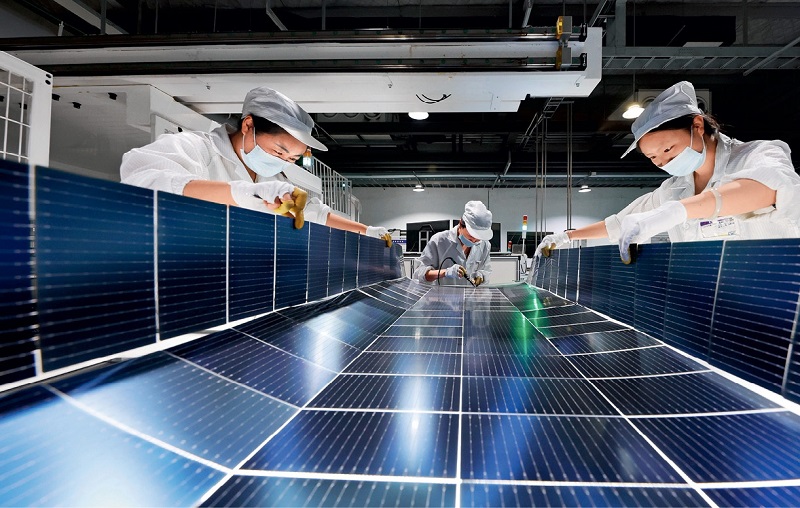This year marks a major milestone in China-EU engagement — the 50th anniversary of the establishment of diplomatic relations between them. Building on this momentum, the two sides released the Joint Statement on Climate Change by Chinese and EU Leaders in July, noting that “in the fluid and turbulent international situation today, it is crucial that all countries, notably the major economies, maintain policy continuity and stability and step up efforts to address climate change.” Showing insightful political commitment, this document will guide China-EU cooperation in green development over the coming 50 years. To translate commitments into reality, China and the EU must understand the shifting role the other side is playing in global climate governance and take pragmatic actions to overcome challenges.

Workers at the workshop of Jiangsu Dongci New Energy Technology Co., Ltd., in Suqian, Jiangsu Province are producing photovoltaic modules for export orders on July 22, 2025.
From Follower to Pacesetter
Climate change is a critical area for China-EU cooperation, marked by both great resilience and high potential. With its strong institutional capacity and normative strength, the EU has remained at the forefront of international climate action over the past decades. It has introduced innovative regulatory frameworks, rigorous environmental standards, and effective carbon pricing systems. Until recently, when asked where to go for the most innovative green ideas, I would always answer — please go to Brussels, Berlin, and Paris.
Now the world’s green landscape is changing dramatically: China has surpassed Europe in most environment areas. Today, my answer is — please go to Beijing, Hangzhou, and Shenzhen. From solar panels and wind turbines to electric vehicles (EVs) and batteries, China’s manufacturing strength provides other developing countries with affordable solutions to reduce fossil-fuel dependency and achieve sustainable prosperity.
In Nepal, I recently observed that most new cars sold are electric; the vast majority being Chinese brands. Across the developing world, you don’t find many solar panels which are not produced by Tongwei, LONGi, Trina Solar, or other Chinese companies. Recently CATL, a leading Chinese EV battery manufacturer, announced huge investments in battery production in Indonesia, and the EV giant BYD agreed on a record-breaking collaboration for energy storage in Saudi Arabia. These all point to the fact that China is now the world’s manufacturing hub of green products and a key driving force in green energy transition. Under these circumstances, China and the EU need to review and recalibrate the model of their cooperation in climate change response from a new perspective.
Fostering Competitive Cooperation
The surge of China’s green industry injects strong momentum into the global response to climate change, and at the same time, creates new issues in its cooperation with the EU. Both sides now face the challenges of properly handling competition amid cooperation to avoid bilateral ties being reduced to a zero-sum game.
A healthy model of cooperation should be based on proper division of labor and complementarity, which are already apparent between the EU and China. In the solar photovoltaics sector, Chinese firms — through fierce competition and relentless innovation — produce nearly 90 percent of the world’s panels, dramatically lowering global prices. And Europe can enhance its position and secure domestic jobs in high-efficiency module design, advanced manufacturing equipment, grid integration, and recycling technologies. This complementarity lays the foundation for win-win cooperation.
Recent EU proposals for tariffs on Chinese EVs, however, risk overshadowing what should be a historic moment for climate cooperation. While Europe’s concerns for its own companies are understandable, protectionist measures will disrupt green supply chains and hinder the pursuit of collective climate goals. Rather than imposing punitive tariffs, the EU and China should focus on constructive dialogues to establish shared technology standards, transparent subsidy rules, and climate-oriented trade frameworks that reward low-carbon innovation. Green technology should become a space for competitive collaboration, where the two sides strive for leadership yet reach agreement on shared rules, open market, and joint investments in resilience, hence progress for both through healthy competition.
Twin Pillars for Climate Governance
The release of the Joint statement on Climate Change by Chinese and EU Leaders marks a good start, but high-level commitment must be translated into tangible action. The EU and China should shield climate diplomacy from geopolitical tensions, ensuring that collaboration remains robust and productive. Climate change is our common enemy, and its urgency doesn’t allow for postponing action until disagreements are resolved.
China’s Ambassador to the EU Cai Run has rightly highlighted that practical cooperation between Chinese and European enterprises in green sectors — from solar and wind energy projects across Europe to geothermal initiatives between China and Iceland — should expand further into joint financing initiatives in third markets such as Africa, Southeast Asia, and Latin America. Combining Europe’s financial and regulatory strengths with China’s engineering expertise can establish a powerful model for global green investment, facilitating energy transition in the Global South.
The climate talks (COP30) in Belém, Brazil, to be held in November, has heightened the world’s attention to the leading role of the EU and China in global efforts to tackle climate change. As we commemorate 50 years of China-EU diplomatic relations, this anniversary presents more than symbolic value — it offers a critical opportunity to shape a shared sustainable future.
The decisions made today will profoundly influence billions of lives, determining whether future generations will inherit a world of conflict and scarcity, or a planet defined by green prosperity and peace. To achieve this vision, China and Europe must proceed not as rivals but as twin pillars of global climate governance, staying committed to cooperation, innovation, and collective responsibility. 
ERIK SOLHEIMFORMER is former UN environment executive director and under-secretary-general of the United Nations.